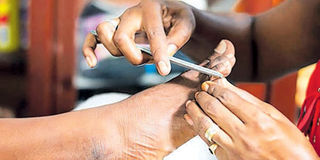Watch those in-grown nails as they sprout

Trim toenails straight across the top. Do not taper or round the corners or trim too short. PHOTO | FILE
What you need to know:
- Until she went to hospital, the 35-year-old had braved the pain for three months with false hope that it was an infection that will go away soon. “The pain was hard to explain…I would massage the toe with warm salty water but this just seemed to make it worse. At some point, I could not touch any of my toes without wincing in pain,”Latigo says.
In 2015, Margaret Latigo was forced to spend Shs300,000 to treat her left toe-nail which had grown into the skin, causing irritation, redness, pain and swelling. In fact, her boss at work could not believe that a ‘simple’ nail would stop one from leaving home. The toe nail became so painful that she could not wear shoes anymore.
Until she went to hospital, the 35-year-old had braved the pain for three months with false hope that it was an infection that will go away soon. “The pain was hard to explain…I would massage the toe with warm salty water but this just seemed to make it worse. At some point, I could not touch any of my toes without wincing in pain,”Latigo says.
After months of self-medication without any relief, Latigo decided to visit a physician.
“He told me I had cut my nails too short allowing the skin to grow around and on top of the nail. And because I kept trying to treat it myself, I made the infection worse,” she says.
In-grown toes
The medicinet health website describes an ingrown toenail (onychocryptosis) as one caused by the pressure from the ingrowth of the nail edge into the skin of the toe.
Once the edge of the nail breaks through the skin, it causes inflammation which largely affects the big toes.
Complications
Dr Fred Kambugu, a dermatologist, says if left untreated, an ingrown toenail infection can cause an infection in the bone. A toenail infection can also lead to foot ulcers, or open sores, and a loss of blood flow to the infected area. Tissue decay and tissue death at the site of infection are possible.
According to health.com, an online portal, a foot infection can be more serious if you have diabetes. Even a small cut, scrape, or ingrown toenail may quickly become infected due to the lack of blood flow and nerve sensitivity.
“See your doctor right away if you have diabetes and are concerned about an ingrown toenail infection,” the site recommends.
Dr Vincent Karuhanga, a general physician at Polyclinic in Kampala, says wearing high heeled shoes throws the weight of the body into the toes and causes the nails to go into the skin. He also warns against the use of antibiotics to treat the condition because it does not bring result.
“Once you realise an ingrown toe nail, try pushing skin away from the toenail edge using a cotton ball soaked in abit of olive oil,” Dr Karuhanga advises.
If left untreated, the ingrown nail can lead to severe complications in form of infections such as Paronychia (locally known as entunuka), a nail disease that is often a tender bacterial or fungal infection of the hand or foot where the nail and skin meet at the side or the base of a finger or toenail.
In this case, Dr Karuhanga advises seeing a doctor for further examination and treatment.
Misconceptions
False: Ingrown toenails always go away on their own.
Truth: If you do not have an ingrown toenail properly taken care of, it can keep coming back. Furthermore, your foot pain could be due to something other than a bad toenail trim. You can not get the right treatment for your foot problem if you do not know what you are dealing with.
False: Ingrown toenail treatment can always be performed at home.
Truth: While it is true there are several conservative treatment measures you can try at home, you should seek medical help if your ingrown toenail does not resolve after careful at-home treatment. It is a good idea to first make sure that your problem really is an ingrown toenail.
False: The shoes you wear have nothing to do with ingrown toenails.
Truth: Wearing properly-fitting, appropriate, sensible footwear can mean the difference between a chronic recurring ingrown toenail and a healthy foot. High-heeled shoes and shoes that are too tight, too loose, or simply ill-fitting can cause painful ingrown toenails.
False: Cutting a notch or curve in the nail will make it grow correctly.
Truth: There is a proper way to cut your toenails whether you have an ingrown one or not. Always cut straight across the nail, do not cut the nail too short, and make sure your feet and your toenail clippers are clean before you trim.
False: Because your grandfather had ingrown toenails, you always will too.
Truth: This one is tricky because ingrown toenails do tend to run in families. So if your grandfather had ingrown toenails, you might be prone to getting them as well. However, there are several things you can do to prevent this painful problem.




